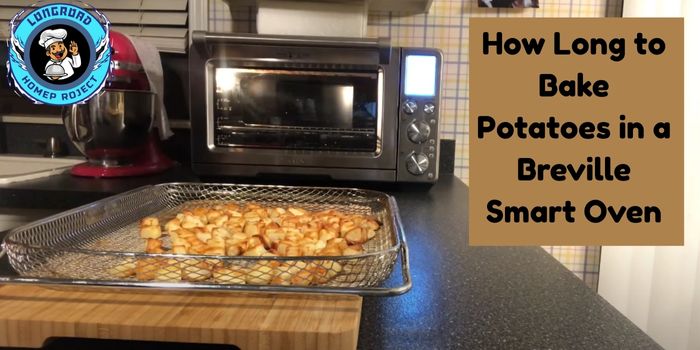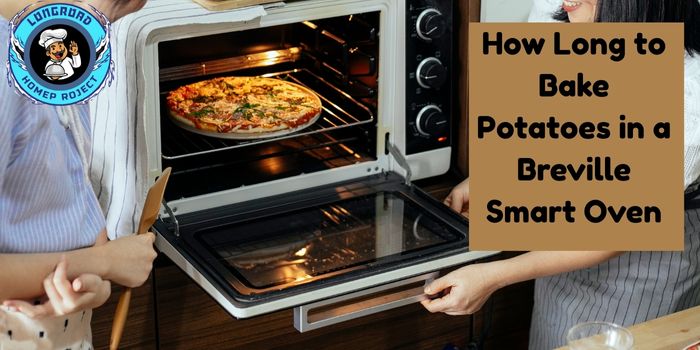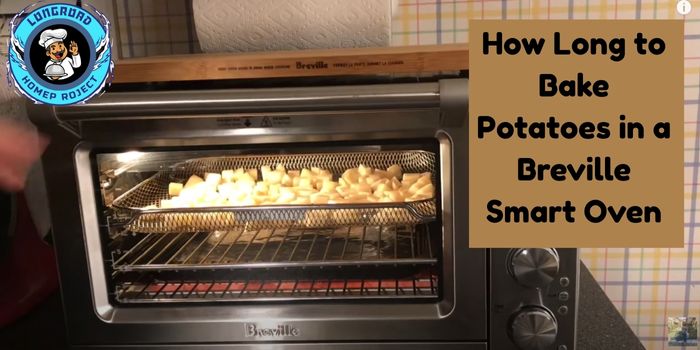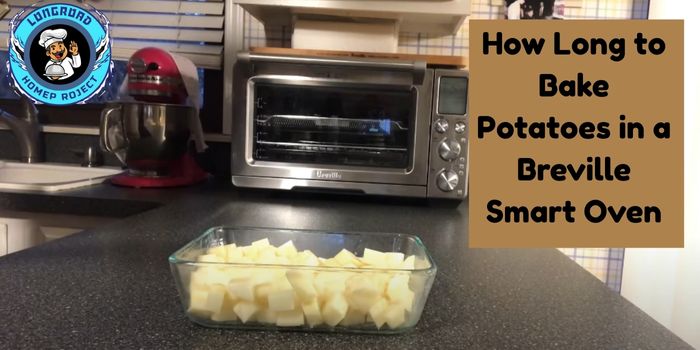As an Amazon Associate I earn from qualifying purchases.
I still remember the first time I tried baking a potato in my Breville Smart Oven—I ended up with a dry, unevenly cooked mess. After a few experiments, tweaks, and reading every manual tip, I finally mastered the process. If you’ve ever wondered how long to bake potatoes in Breville Smart Oven, you’re not alone. Getting that fluffy interior with a perfectly crisp skin can feel tricky, but with the right timing and temperature, it’s completely doable.
In this guide, I’ll walk you through exact baking times, temperature settings, and smart oven techniques that ensure every potato comes out perfectly cooked. Whether you prefer your potatoes wrapped in foil, air-fried, or roasted directly on the rack, this article will give you practical, step-by-step advice. Along the way, I’ll share tips, tricks, and troubleshooting advice I’ve learned from personal experience to help you bake potatoes like a pro—every single time.
By the end, you’ll know not just how long to bake potatoes in Breville Smart Oven, but also how to make adjustments for size, type, and even cooking style to suit your tastes.
Understanding Your Breville Smart Oven
Breville Smart Ovens have become kitchen favorites because they combine versatility, precision, and convenience. From the Combi Wave model to the Air Fryer Smart Oven, these appliances offer multiple cooking modes that can significantly affect baking time for potatoes. Understanding how your specific model works is the first step toward consistently perfect results.
Breville Smart Oven Models
- Breville Combi Wave – This model combines convection baking with microwave speed, allowing potatoes to cook faster while maintaining a fluffy interior. It’s ideal for those who want tender potatoes without waiting for the traditional oven duration.
- Breville Smart Oven Air Fryer – Perfect for baked potatoes with a crispy skin, this model circulates hot air around the potato, reducing baking time compared to standard convection.
- Other Smart Oven Variants – Most Breville ovens include features like convection bake, roast, reheat, and pizza modes. Each mode slightly alters cooking speed and heat distribution.
Features That Affect Baking Time
- Convection Mode: Circulates hot air evenly, reducing cooking time by up to 25% compared to a standard bake. For large potatoes, convection ensures even cooking from skin to core.
- Air Fry Mode: Uses rapid airflow to crisp the skin, ideal if you like that golden, crackly exterior. This method is faster but can dry out the interior if not monitored.
- Smart Settings & Presets: Some Breville ovens have potato or vegetable presets. While convenient, they may require minor adjustments depending on potato size and type.
Related Tips
- Breville Combi Wave baked potato: Use the microwave-convection combination for faster cooking without sacrificing texture. Start with high microwave power for 5–7 minutes, then finish in convection mode for crisp skin.
- Baked potato in Breville Smart oven air fryer: Preheat the air fryer setting, poke holes in the potato, and cook for roughly 35–45 minutes for medium-large potatoes. Turn halfway to ensure uniform browning.
understanding the specific features and modes of your Breville Smart Oven, you can adjust cooking times accurately and achieve consistently fluffy, perfectly baked potatoes with minimal guesswork.

Preparing Potatoes for Baking
Before you even set your Breville Smart Oven to the right temperature, proper potato preparation makes a world of difference in texture, flavor, and cooking consistency. Here’s how to get it right every time.
Choosing the Right Potato
The type of potato you select significantly affects the final outcome:
- Russet Potatoes – Often called baking potatoes, Russets have a high starch content and low moisture, resulting in a fluffy interior and crisp skin. Ideal for classic baked potatoes.
- Yukon Gold Potatoes – Slightly waxy with a creamy texture. They bake well, though their skin may not get as crispy as Russets. Perfect for buttery, soft-centered potatoes.
- Other Varieties – Red potatoes or fingerlings can be baked, but they typically yield a denser, moister interior and may cook faster, so timing adjustments are needed.
Cleaning and Preparing Potatoes
- Wash and Scrub – Use a vegetable brush under running water to remove dirt and debris. Potatoes are grown underground, so a thorough scrub ensures you’re not baking grit into your dish.
- Pierce With a Fork – Poking a few holes allows steam to escape, preventing the potato from bursting in the oven. Aim for 4–6 evenly spaced punctures per potato.
- Optional Seasoning or Oil –
- Oil: Lightly coat the skin with olive or vegetable oil for extra crispness.
- Salt: Sprinkle coarse salt over the oiled skin to enhance flavor and texture.
- Optional Herbs: Rosemary or garlic powder can add an aromatic touch if desired.
Preheating the Oven
- Smart Oven Tip: Always preheat your Breville Smart Oven before inserting potatoes. Convection and air fryer modes benefit from a preheated environment, ensuring even cooking and proper browning.
- Temperature Guideline: For standard baking, preheat to 400°F (204°C). Adjust slightly for air fryer or Combi Wave modes if following specific manufacturer instructions.
By taking these preparatory steps, you set your potatoes up for perfect results—crispy skin, tender interior, and evenly cooked throughout. Proper preparation also reduces the risk of uneven cooking or underdone centers.
Standard Baking Times & Temperatures
Once your potatoes are prepped, understanding the right temperature and timing is crucial to achieving a perfectly baked potato in your Breville Smart Oven. Cooking times vary depending on potato size, quantity, and the specific oven mode you choose.
Temperature Guidelines
- Typical Range: Most baked potatoes perform best between 375°F and 425°F (190–218°C).
- Lower End (375°F): Slower, gentler cooking that helps prevent over-browning while keeping the interior moist.
- Higher End (425°F): Produces crispier skin and slightly faster cooking. Ideal if you want that classic baked potato crunch.
Baking Times by Potato Size
- Medium Potatoes (5–7 oz / 140–200 g):
- Standard baking: 35–45 minutes
- Air fryer or convection setting: 30–35 minutes
- Large Potatoes (8–12 oz / 225–340 g):
- Standard baking: 45–60 minutes
- Air fryer or convection: 40–50 minutes
Tip: To check for doneness, insert a fork or skewer into the center; it should slide in easily with no resistance.
Adjustments for Multiple Potatoes
- When baking more than 2–3 potatoes at once, increase baking time slightly by 5–10 minutes depending on oven capacity.
- Avoid overcrowding the oven tray, as air circulation is critical for even cooking, especially in convection mode.
Using Convection or Air Fryer Modes
- Convection or Breville Smart Oven Air Fryer settings circulate hot air, reducing cooking time and producing a crispier skin.
- Reduce temperature by 25°F if switching from standard baking to convection mode to prevent overcooking the exterior.
- Check doneness 5–10 minutes earlier than the standard baking time to avoid a dry interior.
Quick Reference
| Potato Size | Standard Bake | Convection / Air Fryer |
|---|---|---|
| Medium | 35–45 min | 30–35 min |
| Large | 45–60 min | 40–50 min |
Baking Large vs Medium vs Small Potatoes
When baking potatoes in your Breville Smart Oven, size matters—not just for timing, but for ensuring even cooking and perfect texture. Here’s a clear guide:
| Potato Size | Weight Range | Standard Bake Time (°F 400) | Convection / Air Fryer |
|---|---|---|---|
| Small | 3–4 oz (85–115 g) | 25–30 minutes | 20–25 minutes |
| Medium | 5–7 oz (140–200 g) | 35–45 minutes | 30–35 minutes |
| Large | 8–12 oz (225–340 g) | 45–60 minutes | 40–50 minutes |
Tips for Even Cooking in a Smart Oven:
- Spacing: Leave at least 1–2 inches between potatoes for proper air circulation.
- Rotation: Rotate the tray halfway through baking if your oven has hot spots.
- Check doneness: Use a fork or skewer; all potatoes should be tender inside before removing.

Foil vs No Foil: Which is Better?
A common question for Breville Smart Oven users: should you wrap potatoes in foil or bake them naked? The answer depends on the texture you want.
Wrapping in Foil
Pros:
- Retains moisture, keeping the interior soft and fluffy.
- Ideal for reheating later; prevents the potato from drying out.
Cons:
- Skin will be soft, not crispy.
- May increase cooking time slightly, as foil traps heat differently.
No Foil (Direct Baking)
Pros:
- Skin becomes crispy and golden, perfect for toppings like butter, cheese, or sour cream.
- Faster cooking due to direct exposure to hot air.
Cons:
- Exterior can dry out if overcooked or left too long in the oven.
Breville Smart Oven Tip:
For the classic crispy-skinned baked potato, skip the foil and lightly coat the potato with oil and salt. If you prefer soft skins for wrapping or transport, foil works well.
Using the Air Fryer Function for Baked Potatoes
The Breville Smart Oven’s air fryer mode is a game-changer for baking potatoes. Unlike traditional baking, the air fryer uses rapid circulating hot air, which cooks food faster and gives potatoes a crispy exterior while keeping the inside soft and fluffy.
How Air Fryer Mode Changes Baking Time
Because hot air surrounds the potato evenly, cooking time is reduced by 10–15 minutes compared to standard baking. For example:
- Small potatoes: 20–25 minutes
- Medium potatoes: 30–35 minutes
- Large potatoes: 40–50 minutes
Tip: Always preheat the air fryer function for consistent results, just as you would a conventional oven.
Tips for a Perfect Air Fryer Baked Potato
- Lightly oil the skin: A thin layer of olive oil or avocado oil enhances crispiness.
- Pierce the potato: Prick 3–4 times with a fork to allow steam to escape.
- Single layer cooking: Avoid overcrowding to ensure even air circulation.
- Check for doneness: Insert a fork or skewer; the potato should slide in easily without resistance.
- Optional seasoning: Sprinkle sea salt or garlic powder on the skin before air frying for extra flavor.
Using the air fryer function is ideal when you want a fast, convenient baked potato with that signature crispy skin.
Tips for Perfectly Fluffy & Crispy Potatoes
Getting the ideal baked potato texture—crispy on the outside, fluffy on the inside—can be simple with the right techniques:
- Use a rack for airflow: Placing potatoes on the oven or air fryer rack allows hot air to circulate all around, ensuring even cooking and crisp skin. Avoid baking directly on a tray lined with foil, which can trap moisture.
- Rest before cutting: After baking, let the potatoes rest for 5–10 minutes. This allows steam to redistribute, giving the interior a light, fluffy texture.
- Finish with butter or oil: Brushing a small amount of butter or olive oil over the skin right after baking enhances flavor and crunch.
- Optional toppings: Sea salt, cracked black pepper, garlic powder, or fresh herbs can elevate your baked potato to a restaurant-level side dish.
Tip: For extra crispiness, you can return the potato to the air fryer for 2–3 minutes after adding oil or butter—just watch it closely to avoid burning.
Common Mistakes to Avoid
Even with a Breville Smart Oven, beginners often make mistakes that affect results:
- Not preheating the oven: Skipping preheating leads to uneven cooking and longer bake times. Always allow the oven to reach your target temperature first.
- Overcrowding the tray: Potatoes need space for heat circulation. Crowding can result in uneven baking or soft, soggy spots.
- Baking without checking doneness: Large potatoes may need extra time. Test with a fork or skewer to ensure the interior is fully cooked.
- Wrapping incorrectly in foil: While foil can soften skin, wrapping too tightly or too long can trap moisture and prevent that crispy outer layer.
Following these tips helps ensure perfectly baked potatoes every time, whether you use conventional baking or the air fryer function.
Personal Experience – My Best Breville Baked Potato Method
When I first started using my Breville Smart Oven to bake potatoes, I made every mistake in the book. I’d undercook medium-sized potatoes while trying to get a crispy skin, or overcook smaller ones, leaving them dry inside. It took a few weeks of trial and error to figure out the perfect combination of temperature, timing, and oven function.
One key lesson I learned was that preheating matters more than I realized. Even a minute or two of delay in reaching the target temperature—especially when using convection or air fryer modes—would throw off cooking times by 5–10 minutes. Another discovery was the power of the air fryer function: it drastically reduced cooking time and gave me a consistent golden, crispy skin without drying out the interior.
I also experimented with different potato types. Russets gave me that classic fluffy interior with crisp skin, while Yukon Golds offered a creamier texture. Using a light coating of olive oil and a pinch of salt on the skin before baking became my go-to method for maximum flavor and crunch.
For consistently perfect results, here’s my personal checklist:
- Preheat the Breville Smart Oven to 400°F.
- Scrub and pierce medium or large potatoes.
- Lightly coat with oil and sprinkle salt.
- Use the air fryer function or convection bake for even heat.
- Bake medium potatoes 35–40 minutes; large potatoes 45–55 minutes.
- Rest for 5–10 minutes before cutting to let steam redistribute.
After following this method, every potato comes out crispy on the outside, fluffy on the inside, and ready for any topping—from classic butter and sour cream to roasted garlic or shredded cheese. It’s a simple process, but one small adjustment at each step makes all the difference.

FAQs
1. How long does it take to bake a potato in a Breville Smart Oven?
For medium potatoes, expect 35–45 minutes at 400°F, and for large potatoes, 45–60 minutes. Convection or air fryer modes may slightly reduce these times.
2. Can I bake potatoes faster using the air fryer function?
Yes! The air fryer function circulates hot air more efficiently, usually shaving 5–10 minutes off the baking time while still giving a crispy skin and fluffy interior.
3. Do I need to wrap potatoes in foil?
Foil helps retain moisture but prevents a crispy skin. For crispy skins, bake directly on the rack; for softer skins, wrap in foil.
4. How do I know when a potato is fully cooked?
Pierce with a fork or skewer. It should slide in easily without resistance, and the potato should feel soft but not mushy.
5. Can I bake multiple potatoes at once without increasing time?
Yes, as long as they are spaced evenly on the rack to allow airflow. Overcrowding can increase cooking time slightly.
6. Is it faster to bake in the Breville oven or an air fryer?
The air fryer mode is typically faster by 5–10 minutes because of better air circulation. Standard convection baking takes slightly longer but is excellent for uniform results.
7. Should I pierce the potato before baking?
Yes! Piercing allows steam to escape, preventing the potato from bursting in the oven.
8. What’s the best potato type for baking in a smart oven?
Russet potatoes are ideal for fluffy interiors with crisp skins. Yukon Golds work well for creamier textures but may not crisp as much.
9. Can I bake sweet potatoes the same way?
Absolutely! Sweet potatoes typically take 5–10 minutes longer than standard baking potatoes, depending on size.
10. How do I avoid soggy skins?
Use a light coating of oil and bake directly on the oven rack, allowing air to circulate. Avoid foil if you want a crispy exterior.
Conclusion
Baking the perfect potato in a Breville Smart Oven comes down to understanding size, temperature, and oven function. Medium potatoes take 35–45 minutes, while large ones need 45–60 minutes at 400°F. Using the air fryer function can speed things up and deliver beautifully crispy skins.
Experiment with foil, potato types, and oven settings to find your ideal balance of fluffy interior and crisp exterior. By following these tips, you’ll consistently bake delicious potatoes and master your Breville Smart Oven with confidence. Knowing how long to bake potatoes in Breville Smart Oven ensures you get restaurant-quality results every time.
As an Amazon Associate I earn from qualifying purchases.
